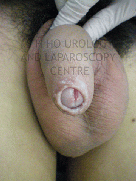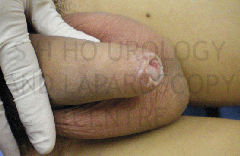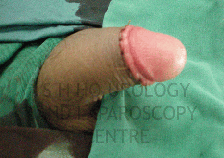











Balanitis xerotica obliterans (BXO) or Lichen sclerosus (LS) of the genitalia is a chronic and progressive inflammatory disorder involving
the skin of the penis. It commonly affects the foreskin but may also affect the penis and urinary opening as well as the urine tube
(urethra).
It affects about 6 in 1000 males. The exact cause of BXO is not known. There is a suggestion of genetic basis. It
has some association with autoimmune disease such as vitiligo, alopecia, thyroid disease and diabetes. It is not known to be associated
with any infection of the genitalia.
BXO can occur in both uncircumcised and circumcised men.
In early BXO, there may be non-specific symptoms such as itch, burning sensation during passage of urine, penile discharge and decreased
in sensation of the glans penis.
As BXO advances in uncircumcised men, it causes thickening and scarring of the foreskin, resulting
in a condition called phimosis. Phimosis is the inability to retract the foreskin over the glans penis.
As BXO extends to the
glans penis, it would lead to disfiguration of the glans. A hard, white ring will appear at the tip of the penis. The corona and frenulum
may be destroyed. Involvement of the urinary opening or the urine tube will result is formation of scar tissue, leading to obstruction
of urine flow. In very advanced cases, it urinary stones may form and complete urinary obstruction and retention may occur.
If
the condition is left untreated, it may gradually extend to involve much of the foreskin, the glans penis and the urinary passage.
In majority of cases, the condition is confined to the foreskin and treated permanently by circumcision. Recurrence in these situations
is not likely.
The illustration on the left shows the effect of circumcision in completely removing the diseased BXO foreskin,
leaving a healthy glans penis.
In cases of minor glans involvement, circumcision usually stops the condition from progressing but the white and hardened ring at
the tip of glans penis will remain.
The illustration on the left shows a small ring of white and hard tissue at the tip of the
penis, indicating minor involvement of the glans penis that is unlikely to progress.
Very occasionally, the condition progresses to cause severe scarring of the urinary opening and urinary tube. Minor reconstructive
surgery such as meatoplasty is performed if the involvement is limited to the urinary opening. Involvement of the urinary tube will
require major excision and reconstruction surgery.
Steroid cream application has been prescribed for some early cases with minor
glans penis involvement to prevent progression. Steroids are not likely to reverse the disease and are not known to be effective in
advanced cases.
